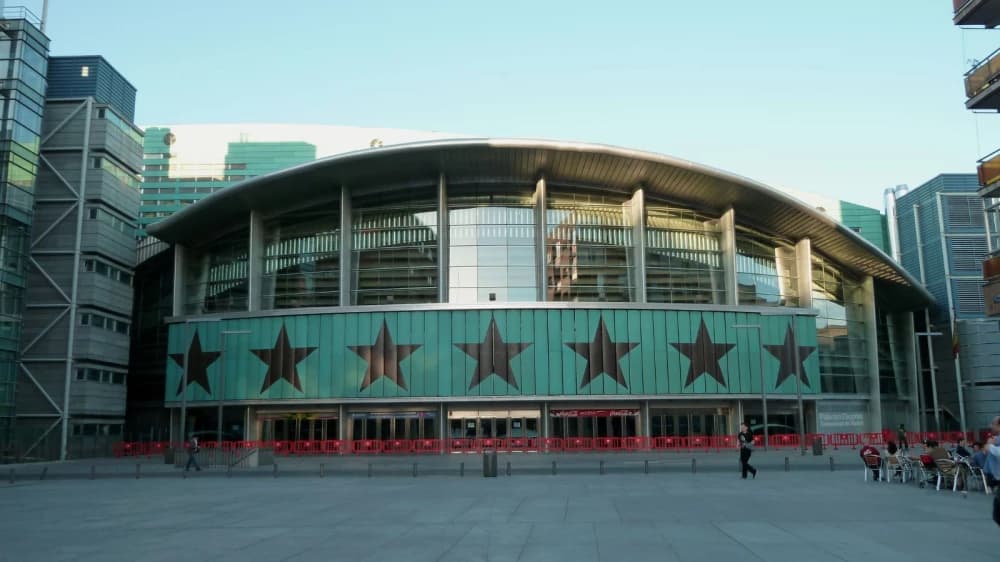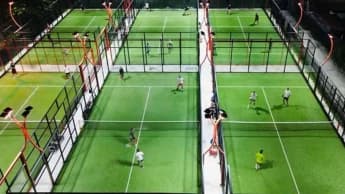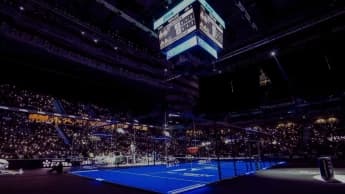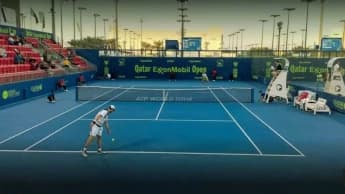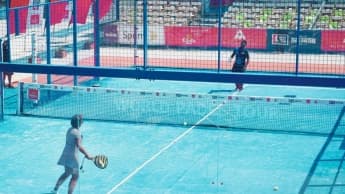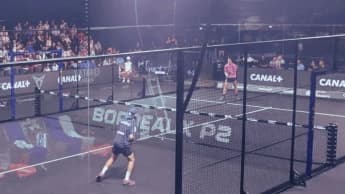The WiZink Center, nestled in Madrid, has evolved from a multi-purpose arena to a premier destination for padel enthusiasts, hosting prestigious tournaments and celebrating the sport's growing popularity.
The WiZink Center, situated in the lively center of Madrid, Spain, is a prestigious location that has become a hallmark for top-tier padel competitions. Initially constructed as an indoor venue for concerts and various sporting events, it has evolved into a leading hub for padel. This contemporary facility represents the increasing popularity of the sport in Spain and beyond, providing an ideal environment for both professional tournaments and casual play. Its prime location in Madrid, a city rich in sporting tradition, further bolsters its status as a premier padel venue.
A key feature of the WiZink Center is its carefully engineered courts, which meet international standards, providing an ideal playing surface for both amateur and professional players. The arena's versatility allows it to host a variety of events, ranging from local competitions to esteemed international tournaments, attracting some of the top padel players globally. Its layout is designed to accommodate large audiences, with plenty of seating and great sightlines, ensuring fans can experience the action up close. Furthermore, the venue is outfitted with advanced lighting systems, making it possible to hold evening matches, which adds an exciting element to the events hosted there.
One of the most attractive features of the WiZink Center for athletes is its dedication to offering top-notch facilities. The court surface is meticulously maintained, providing a consistent and dependable playing experience. Additionally, the venue provides outstanding amenities, such as modern locker rooms, player lounges, and exceptional service during events, all of which foster a professional and comfortable environment for competitors. Furthermore, the venue's close-knit yet vibrant atmosphere, where fans are close to the action, generates a distinctive energy that serves as a motivating factor for the players.
The WiZink Center is capable of hosting both prestigious international padel tournaments and smaller local events, making it a welcoming venue for players of varying skill levels to demonstrate their abilities. Its status as a premier sporting venue, along with its accessibility and central location, positions it as a top choice for padel fans, not just in Spain, but also internationally. The overall experience of playing at the WiZink Center—combined with its professional-standard courts, excellent location, and vibrant atmosphere created by the audience—distinguishes it as an exceptional venue in the padel community.
History
The WiZink Center, situated in the center of Madrid, Spain, boasts a rich and dynamic history that has established it as a prominent venue for padel events. Initially designed as a versatile indoor arena, it has experienced various transformations, with padel recently becoming an integral part of its identity.
Inception and Initial Construction (2005): The WiZink Center, originally referred to as the Palacio de los Deportes, was officially opened in 2005. It was intended to function as an indoor sports and entertainment facility for Madrid, capable of hosting a wide array of events, such as concerts, basketball matches, and various sporting competitions. Although it was not initially designed for padel, the venue quickly earned a reputation for its adaptability and contemporary design, which featured excellent acoustics, ample seating, and top-notch amenities. Its versatility to accommodate different types of events made it a favored location in the city.
Transition to a Padel Venue (2015-2016): In 2015, as the popularity of padel surged in Spain, the WiZink Center started to consider adding this sport to its event lineup. At that time, Madrid had established itself as a key hub for padel, with a growing community of players and a rise in tournaments. By 2016, the venue officially became known as a padel destination, starting with its inaugural high-profile event. This transition was motivated by the need to support the expanding padel community in Madrid, and the WiZink Center's versatile infrastructure positioned it well for hosting such events.
The Arrival of Major Padel Tournaments (2017-2018): In 2017, the WiZink Center hosted its inaugural major padel competition, marking a significant achievement for the venue. This event was highly successful and demonstrated the center’s ability to host padel competitions alongside other sports. By 2018, it had established itself as a regular venue for international padel tournaments, including the prestigious World Padel Tour (WPT) events. The center's location, amenities, and facilities contributed to its status as an ideal site for such competitions, reinforcing Madrid’s reputation as a hub for padel.
Ongoing Development and the Future of Padel at WiZink Center (2019-Present): As the WiZink Center gained prominence within the padel community, it underwent a series of renovations and upgrades to better accommodate the needs of players and spectators. These improvements included enhancements to the playing surfaces, seating arrangements for spectators, and lighting systems, which ensured the center could uphold the high standards necessary for major competitions. The success of these events has also attracted top padel players from around the globe, boosting the center's visibility on the international stage.
Prominent names in the world of padel, including legends like Fernando Belasteguín and Juan Martín Díaz, as well as current stars such as Alejandra Salazar and Mapi Sánchez Alayeto, have all played at the WiZink Center. Their participation in events there has significantly contributed to elevating the venue's status, establishing the WiZink Center as one of the premier padel locations worldwide.
Motivations for Establishing a Padel Venue: The motivation for transforming the WiZink Center into a padel venue stemmed from the rising demand for high-quality facilities to accommodate the increasing number of padel fans and international competitions. The sport has gained significant popularity, especially in Spain, leading to the necessity for venues like the WiZink Center that can provide excellent infrastructure for both players and audiences. Its location in a central and well-connected city such as Madrid positioned the WiZink Center as a perfect site for these events.
Furthermore, the venue's past achievements in organizing various sports and entertainment events facilitated a seamless integration into the padel environment. The arena's versatility, along with Madrid's vibrant sports culture, established the WiZink Center as a focal point for elite padel competitions in Spain and throughout Europe.
Currently, the WiZink Center remains a pivotal location in the padel community, hosting prominent tournaments that draw thousands of spectators and highlight exceptional talent in the game. Its transformation from a versatile venue to a specialized padel center represents an important milestone in the sport's history.
Evolution
The WiZink Center, which first opened as the Palacio de los Deportes in 2005, has undergone a significant transformation since its establishment. Originally meant to host a variety of events, from concerts to different sports, it was not designed specifically as a padel venue. However, with the surge in popularity of padel in Spain, the demand for high-quality, professional facilities to host major events became evident. In 2016, the WiZink Center hosted its first major padel event, marking the start of its journey to becoming a leading padel destination. This transition was fueled by the increasing need for larger venues capable of accommodating international padel tournaments.
From 2017 to 2018, the WiZink Center underwent significant renovations to fulfill the demands of high-level padel. These updates included the installation of professional-caliber courts and enhancements to the lighting for improved visibility during both day and night matches. The seating configurations were reworked to provide better views of the action, allowing spectators to become fully engaged in the experience. In addition to these physical improvements, the player amenities were upgraded as well, featuring the creation of modern locker rooms, VIP sections, and enhanced player lounges. These upgrades enabled the venue to meet the rising expectations of professional athletes and accommodate a growing number of international events.
As the World Padel Tour expanded, the need for venues capable of hosting significant tournaments increased. In response, WiZink Center made further investments to enhance the fan experience, which included the installation of larger screens and improved digital signage to give spectators real-time updates, statistics, and highlights during the matches. The arena's digital footprint was also revitalized, transforming it into a modern center for padel and fostering greater engagement with its growing fan base. Additionally, the lighting system was continuously upgraded to ensure optimal conditions for both players and fans, no matter the time of day.
The primary factors driving these changes were the swift rise of padel as a popular sport and the necessity of sustaining Madrid’s reputation as a center for prestigious competitions. By consistently enhancing its facilities, WiZink Center ensured it could fulfill the requirements of elite padel events, draw in international athletes, and deliver an extraordinary experience for spectators. The venue’s versatility for various events, paired with its dedication to offering top-notch amenities, was essential to its success as a leading padel venue.
These modifications have significantly influenced the player experience, creating a dependable, world-class environment where elite athletes can showcase their skills. The enhanced court surfaces, lighting, and proximity to spectators contribute to the vibrant atmosphere of padel matches, allowing players to draw inspiration from the crowd's energy. As it continues to evolve, the WiZink Center has firmly established itself as one of the premier padel venues worldwide, consistently attracting major international events and helping to elevate the sport to unprecedented levels.
Features
The WiZink Center in Madrid is not only a premier destination for padel but also a state-of-the-art facility that incorporates the latest technologies to ensure an exceptional experience for both players and spectators. This venue features several top-quality padel courts, each meticulously designed to offer optimal playing conditions for elite competitions. Constructed to fulfill the rigorous standards of international tournaments, these courts utilize advanced materials that guarantee lasting durability while upholding high performance levels. The surfaces of the courts combine traditional and contemporary materials, including artificial grass and glass panels, specifically tailored for padel, which significantly enhances visibility of the game from every angle.
The dimensions of the courts adhere to international standards, ensuring uniformity in competitive matches. The panoramic glass walls are a standout feature, enabling fans to view the action from multiple perspectives, creating an immersive experience that distinguishes the WiZink Center from other venues. The layout fosters an environment where both players and spectators feel actively involved in every element of the match.
Beyond the courts, WiZink Center boasts an extensive array of amenities designed to enhance the comfort and convenience of both players and visitors. The facility features spacious and well-appointed changing rooms with showers, lockers, and seating areas for players to relax and ready themselves for games. These locker rooms are carefully designed to cater to the needs of professional athletes, providing ample space and privacy to ensure comfort before and after competitions. Additionally, the venue includes social areas such as a café and lounges, offering a modern and stylish space for visitors to connect and unwind, solidifying the venue’s role as a community hub for padel enthusiasts. Another standout feature is the pro shop on-site, which offers a wide selection of padel equipment and apparel, making it the perfect destination for both casual and competitive players seeking the latest gear.
A notable aspect of the venue is its cutting-edge lighting system, which guarantees excellent visibility for players and spectators alike. Utilizing high-quality LED technology, the lighting allows matches to be held in dim conditions without compromising visibility or clarity. This feature is particularly crucial for evening events, as the bright and evenly distributed light maintains the action's visibility, minimizing shadows and glare that could distract from the game. The system is crafted to enhance the playing experience, alleviating eye strain and setting the perfect ambiance for both athletes and the audience.
WiZink Center is dedicated to making sure that all visitors, regardless of their mobility requirements, can fully enjoy the venue. It is entirely accessible for people with disabilities, featuring ramps for easy access, designated seating areas, and accessible restrooms. This commitment to inclusivity highlights the venue's goal of providing a welcoming atmosphere for everyone attending, ensuring that all fans and players can experience a world-class environment without any obstacles.
The stunning panoramic views at the WiZink Center, along with its glass walls, offer both aesthetic and functional benefits, establishing it as one of the most visually dynamic padel venues in the world. These views enhance the atmosphere and create an exhilarating environment, allowing fans to see the entire court simultaneously, including all the intense action, dramatic plays, and rallies that define the sport.
Alongside its core features, WiZink Center consistently enhances its facilities to meet the increasing demands of contemporary padel. The venue has adopted state-of-the-art technological systems to monitor player performance, including video analysis tools that players and coaches can utilize for training purposes. This innovative strategy ensures that WiZink Center remains at the leading edge of the sport, providing an exceptional training environment for athletes while delivering an outstanding experience for spectators. The blend of advanced infrastructure, inclusive design, and dedication to both player and fan satisfaction has positioned WiZink Center as a global frontrunner in padel venues, drawing international competitions, top players, and expanding audiences.
History of Layouts
The arrangement of a venue is crucial in determining its functionality, attractiveness, and the overall experience of visitors. Whether it is a sports arena, concert hall, or conference center, the organization of the space influences both how engaged attendees are with the event and the effectiveness of event operations. A thoughtfully designed venue layout guarantees that the audience has an unobstructed view of the events, that the staff can manage the crowd efficiently, and that performers or speakers have all the necessary resources readily available.
Entrance and Foyer Areas
The initial impression of a venue begins at its entrance. A thoughtfully designed entrance and foyer area establish the atmosphere for the event. Typically, this area is spacious, facilitating smooth entry and exit for attendees. A large, well-lit foyer usually includes ticketing counters, information desks, and security checkpoints. This space is essential for effective crowd management, helping individuals to orient themselves before proceeding to the main event areas.
Numerous venues take advantage of the foyer to enhance branding, display event sponsors, or sell merchandise. It can act as an interactive space, particularly for events such as conferences or trade shows, where participants can network or explore exhibits prior to the main event commencing.
Seating Arrangements
A crucial aspect of any venue design is the seating arrangement. In sports venues, seating is usually tiered to ensure that all attendees have unobstructed views, no matter their location. In contrast, concert venues may offer either fixed seating or general admission, with specific areas reserved for VIP or premium seating, providing better views or exclusive access.
The arrangement of seating also considers the flow of the crowd. Venues are designed to avoid overcrowding by providing numerous exits and convenient access to restrooms, food, and beverage stands. Many contemporary venues utilize a mix of flexible seating and fixed sections to accommodate various configurations depending on the type of event, such as a sporting event, concert, or corporate gathering.
Venue for Performances or Events
The main event space is central to any venue, whether it consists of a stage, court, or arena floor. This area must be tailored to meet the specific needs of the event. For instance, a sports venue may feature a large playing field or court, while a concert venue might require a stage and a sound system that are carefully set up to ensure sound reaches every part of the space.
In certain locations, such as convention centers or exhibition halls, the event space can be quite versatile. These venues typically feature movable walls that enable organizers to modify the space according to the size and requirements of the event. This flexibility makes them particularly suitable for trade shows, conventions, and other large events, where the layout may need to adapt dynamically to meet the demands of the occasion.
Additional Areas and Facilities
Behind the scenes, a venue is outfitted with various auxiliary spaces to facilitate the efficient operation of an event. These may include dressing rooms, storage spaces, and equipment rooms. At sports venues, you will often find locker rooms, medical facilities, and coach offices located nearby. In concert venues, green rooms and backstage areas are vital for the performers.
An effectively organized venue layout features sufficient restroom facilities, food courts, and bars that are thoughtfully located for convenience while maintaining the event's flow. Concessions, VIP lounges, and hospitality suites are typically situated in prime areas, granting exclusive access and ensuring comfort for distinguished guests and participants.
Technology and Infrastructure
Contemporary venues are increasingly dependent on state-of-the-art technology to provide outstanding experiences for attendees. The venue's infrastructure should feature high-speed internet access, robust sound systems, LED lighting, and video display systems that foster immersive experiences for the audience. In large sports arenas, jumbotrons and scoreboards play a vital role in showing live game updates, whereas in concert venues, sophisticated sound and lighting systems enhance the overall atmosphere.
The arrangement of these technological elements is equally important. For instance, the placement of lighting rigs and audio systems needs to be accurate to prevent blocking sightlines while ensuring effective coverage of the event. Venue designers frequently collaborate with AV experts to guarantee that every technological detail integrates smoothly with the environment.
Accessibility and Flow
A crucial aspect of any venue design is providing accessibility for all participants, irrespective of their physical capabilities. Key features for inclusivity include designated seating areas, ramps, elevators, and accessible restrooms. Additionally, having clear signage and spacious aisles facilitates easy movement within the venue, allowing individuals to navigate the space comfortably.
Effective flow is essential, especially in large venues expecting significant attendance. A well-designed layout with clear pathways helps to avoid bottlenecks and minimizes wait times. Careful planning allows attendees to navigate the venue easily—such as moving from the entrance to their seats or transitioning between food stalls and the event area—without encountering congestion.
Parking and Transportation
The arrangement of the parking area and the available transportation options play a vital role in the success of a venue. Adequate and accessible parking facilities are necessary for large gatherings. Venue layouts commonly feature parking structures or outdoor lots that are strategically placed near the entrance or exit to reduce the time required for attendees to arrive or leave.
Alongside parking facilities, the layouts of venues frequently feature convenient access to public transportation. Often, bus stops, metro stations, or tram lines are included in the venue's design or located within a short walking distance. This enhanced accessibility facilitates a smooth experience for event attendees, alleviating transportation stress and boosting overall attendee satisfaction.
The configuration of a venue significantly influences the outcomes of the events held within it. A well-thought-out venue fosters an enjoyable and comfortable environment for attendees, meets all technical and operational requirements, and equips organizers with the necessary tools to effectively manage large audiences. Conversely, a poorly designed venue layout can lead to frustrating experiences for both attendees and event planners. On the other hand, a well-structured layout facilitates smooth operations, ensures a positive reception, and leaves a memorable impact.
The layout of a venue is not merely about the physical distribution of areas; it is a thoughtfully designed framework that enhances functionality, aesthetics, and the overall success of an event. From ensuring audience comfort to creating optimal conditions for performers and organizers, every element of the layout plays a vital role in delivering a memorable event experience.
Legendary Competitions
Madrid Padel Open: The Madrid Padel Open, taking place every year at the WiZink Center, is one of the most eagerly awaited events in the professional padel calendar. This esteemed tournament draws elite players from across the globe and has become a significant occasion for fans of the sport. With its vibrant atmosphere and thrilling matches, the event has reinforced the WiZink Center’s status as a premier venue for padel in Spain and around the world.
The event is recognized for highlighting the talents of both up-and-coming and experienced players, featuring intense matches that frequently include dramatic comebacks, strategic excellence, and unforgettable moments. The large, passionate crowd that fills the stands contributes to the thrilling atmosphere, transforming the Madrid Padel Open into more than just a competition; it becomes a celebration of the sport. Being part of the World Padel Tour ensures that it remains a key event for padel enthusiasts and a vital tournament for players aiming to leave their mark.
Mutua Madrid Open (Tennis): The Mutua Madrid Open is a renowned tennis tournament that occurs each year at the WiZink Center, featuring both ATP and WTA tours. Taking place on Madrid's clay courts, this tournament is a significant event in the lead-up to the French Open and draws some of the most celebrated players in tennis.
With a rich history of thrilling matches and high-stakes competition, the tournament has featured incredible players such as Rafael Nadal, Novak Djokovic, and Serena Williams on its courts. The venue’s world-class facilities and enthusiastic fanbase ensure it remains an iconic stop on the tennis calendar. Throughout the years, the tournament has produced some of the sport's most exhilarating and unforgettable moments, further solidifying WiZink Center’s status as a premier tennis destination.
The Magic Box: Although it is not a single tournament, the 'The Magic Box' series, which includes events like the Spanish Padel Championship, has been held at the WiZink Center and has become a key venue for high-level padel competitions. Located in the heart of Madrid, this tournament series attracts both national and international fans, providing a platform to showcase skill and athleticism. The venue’s modern design and cutting-edge facilities create an ideal setting for elite players to compete in one of the most intense environments in the sport.
These events are renowned for their lively atmosphere and often draw large crowds of fans, creating an exciting environment. Players engage in fierce and closely contested matches, resulting in unforgettable experiences for those fortunate enough to attend. The WiZink Center maintains its status as a prominent venue in the world of Spanish padel through these tournaments, playing a significant role in the sport's growth in the area.
Legacy and Event: The WiZink Center, a landmark sporting facility in Madrid, is renowned in the world of padel. Since its inception, this venue has hosted many of the sport's most important events and has been instrumental in promoting padel both in Spain and abroad. Among its various prestigious tournaments, the Madrid Padel Open stands out. This tournament, part of the World Padel Tour, has drawn elite players from across the globe, including many of the sport's most celebrated figures. Over the years, the event has gained significance and is now regarded as one of the premier tournaments on the calendar. The combination of fierce competition and an enthusiastic audience has transformed the WiZink Center into a true sanctuary for padel lovers.
In addition to the Madrid Padel Open, the venue has also hosted national padel championships and various invitational events, further solidifying its reputation as one of the premier locations for padel. The WiZink Center's ability to hold large crowds and create an exciting atmosphere has made it a favorite destination for both players and fans. Its influence goes beyond merely hosting prominent events; it has also played a vital role in the local community by providing a platform for padel players of all skill levels to showcase their talents. The venue has drawn international interest, boosting tourism and economic activity in the surrounding region. Fans from all over Spain and beyond flock to Madrid for major padel events, supporting local businesses and positively impacting the economy. Furthermore, the WiZink Center has contributed to raising awareness of padel as a sport in the area. Madrid, already rich in sporting culture, has seen padel gain greater acceptance, especially among younger generations. The success of events at the WiZink Center has been crucial in motivating the next generation of padel players and enthusiasts, leading to the emergence of more facilities and clubs within the city.
Looking ahead, the WiZink Center is set to maintain its essential role in the realm of padel. The venue's long-term plans involve further improvements to its facilities and enhancing the experience for both players and spectators. As the popularity of padel continues to rise, the WiZink Center is expected to increase its capacity and adopt new technologies to meet the evolving needs of the sport. The management team is committed to preserving its status as a leading padel venue by frequently hosting major tournaments and ensuring the facility remains cutting-edge. With the global growth of padel, the WiZink Center's reputation is likely to expand, further cementing its status as one of the most notable and respected venues in the sport.
Criticism
Although the WiZink Center plays a crucial role in the padel community, it has encountered several criticisms and limitations over the years. One of the most frequently mentioned issues is the cost of tickets and bookings. Given the venue's prominent status, the prices for attending events, particularly significant tournaments like the Madrid Padel Open, can be quite high. This has made it difficult for some fans to participate, especially those who wish to experience the atmosphere but are put off by the expense. Additionally, reserving a court at the WiZink Center can often be a struggle. While the venue boasts a variety of facilities, the high demand during peak times can make it hard to find a available slot for casual play. This situation has caused frustration among local padel enthusiasts who may find it challenging to access the courts, especially on weekends or during major events.
Regarding maintenance, some users have noted that certain areas of the venue, such as seating and locker rooms, could benefit from improvements in cleanliness and upkeep. Although the venue is generally well-kept, there have been occasional reports of service quality issues in specific sections, especially during peak times when multiple events are taking place. Additionally, while the venue provides a range of amenities, it may lack certain features expected in other upscale sporting facilities. For instance, the food and beverage options available may not always accommodate a diverse array of dietary preferences, which could be enhanced to offer a more inclusive experience for guests.
Another area of concern is the absence of outdoor padel courts. Considering Madrid's temperate climate, the opportunity to play on outdoor courts would provide a more varied experience; however, the WiZink Center is entirely enclosed, limiting options for players who prefer outdoor play. Moreover, although the location is central, it can be challenging for some spectators to access via public transport, particularly during major events when transit networks tend to be more crowded. While these factors do not detract from the venue's popularity and importance in the padel community, they are important to consider for potential enhancements to the overall experience for both players and spectators.

